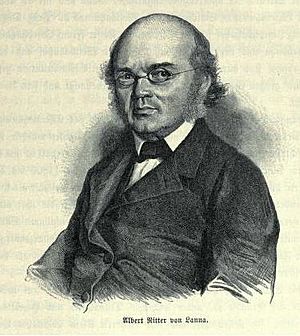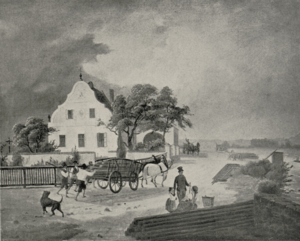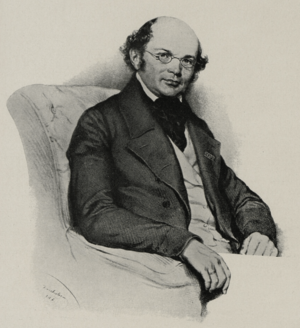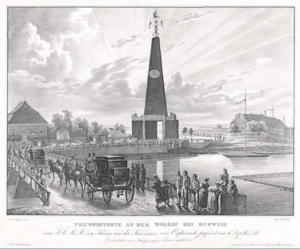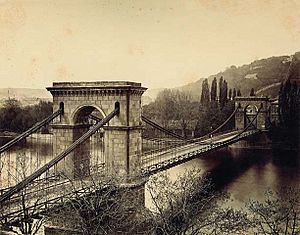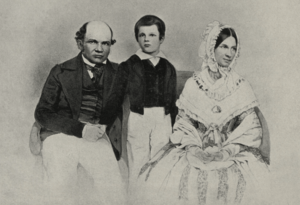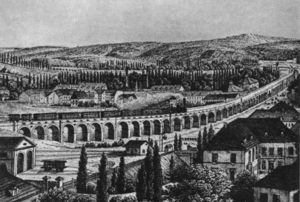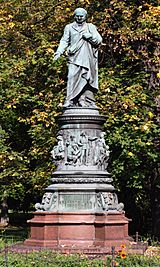Adalbert Lanna the Elder facts for kids
Adalbert Lanna the Elder (born Vojtěch Lanna; April 23, 1805 – January 15, 1866) was a famous Czech shipmaster, merchant, and builder. He started his business by trading salt and wood on the Vltava River. Soon, he expanded into many other areas like construction, coal mining, iron processing, and even brewing beer! He helped grow the economy in many places, including his hometown of České Budějovice, and also in Týn nad Vltavou, Kladno, and Prague.
Contents
Life Story
Childhood and Early Years
Vojtěch Lanna the Elder was born on April 23, 1805, in Čtyři Dvory, which is now part of České Budějovice. His family, the Lannas, had moved to České Budějovice from Austria in the early 1700s. Vojtěch was the second child of Tadeáš Lanna, a shipmaster, and Terezia Lanna Sr.
After high school, Vojtěch went to the České Budějovice gymnasium, just like his older brother Jan and younger brother Ferdinand. In 1820, when he was sixteen, Vojtěch followed his brother Jan to Prague. Unlike his brothers, he chose to study at the Prague polytechnical institute. He was very interested in mechanics and engineering. However, he had disagreements with the director, František Josef Gerstner, and was asked to leave the school.
Vojtěch returned home and started working on ships. He helped transport salt from České Budějovice to Týn nad Vltavou. His father also taught him how to build ships. He learned to pick the right trees in the forests and manage how they were used. In 1825, he passed an exam that allowed him to be in charge of river shipments. That same year, he made his first trip with his own cargo. He sailed along the Vltava and Elbe rivers all the way to Hamburg.
In 1828, Vojtěch's father, Tadeáš Lanna, passed away. Vojtěch's older brother Jan was working as a lawyer for a noble family. So, Vojtěch Lanna the Elder took over the family business. He also became responsible for his mother and four younger siblings.
Growing His Business (1830s)
Besides salt, Adalbert Lanna the Elder started shipping construction wood and graphite. In the early 1830s, a horse-drawn railway between České Budějovice and Linz was completed. Adalbert Lanna managed to get a lease to operate the entire railway for several years. This helped him a lot with bringing in salt from Austrian mines. The railway also carried passengers. The trip from České Budějovice to Linz took a whole day. So, Adalbert Lanna built a large inn at the main stop in Kerschbaum for travelers to rest.
He also got permission to extend the railway right into the center of České Budějovice. It went all the way to the Green Branch Inn, which he had inherited from his father. This inn became a key place for moving goods from the railway onto ships on the Vltava River.
Adalbert's mother died in June 1832. Six months later, Adalbert married Filipina Peithner from Lichtenfels. Sadly, Filipina died suddenly a year and a half later. Six months after that, Adalbert married her younger sister, Josefína.
In the 1830s, Adalbert Lanna the Elder leased all the river structures on the Vltava River between České Budějovice and Prague. He was in charge of building and maintaining them. In 1833, he also leased all river structures on the Vltava and Elbe rivers from Prague to the border with Saxony. He even tried to get permission from Emperor Francis II to make the upper Vltava River navigable at his own expense. In return, he wanted to be the only one allowed to transport goods on that part of the river for fifteen years, but his idea was not accepted.
Adalbert Lanna the Elder knew it was important to have good relationships with powerful people. In 1835, he invited important officials for a river cruise on the Vltava. He wanted to show them how important his river projects were. That same year, Emperor Francis II visited České Budějovice. To honor the emperor, Adalbert built a huge festive gate with a 66-meter tall monument right next to his shipyard. He also gathered his employees to cheer for the emperor and empress. This grand welcome helped Adalbert Lanna the Elder receive a special award from the emperor.
In May 1836, Adalbert and Josefína had their first child, a son named Adalbert Lanna the Younger. The family became very wealthy. The value of goods shipped from České Budějovice down the Vltava River tripled between 1832 and 1838, and a large part of those profits went to the Lanna family.
Big Projects and New Ventures (1840s)
In November 1840, Adalbert Lanna the Elder bought Poříčí Castle, along with its land and nearby villages. At his new castle, he rebuilt the local brewery. He wanted to make beer using a new, popular method called bottom fermentation. He also created a beautiful English-style park east of the castle.
In the same year, construction began on the Emperor Francis chain bridge in Prague. Lanna's company supplied all the materials for this big project. Wood came from the Bohemian Forest, iron from ironworks, and stone from a new quarry Lanna set up. When it was finished in 1841, it was only the second bridge over the Vltava River in Prague. At the same time, Lanna's company also built Prague's first stone embankment, which is now called Smetana's Embankment. These projects showed how much Lanna's business was growing.
He also helped build the first Bohemian steamboat, which sailed on the Elbe River in 1841. From 1844, he started working on making the Nežárka and Lužnice rivers easier to navigate. A year later, he got a contract to build Prague's first railway station. He also worked with the Klein brothers to build the railway between Prague and Olomouc.
From 1843 until he died, Lanna was a member of the "Patriotic-Economic Society in the Kingdom of Bohemia." In 1847, he offered to supply gypsum stone from Austria.
In 1847, Lanna's company made the Blanice River navigable and built the Stádlec Suspension Bridge over the Vltava River. This bridge created a direct road connection between the towns of Písek and Tábor. The Bohemian governor, Archduke Stephan Habsburg-Lorraine, even attended the bridge's foundation stone ceremony.
That same year, Adalbert Lanna the Elder got involved in coal mining near Kladno. He started a mining company with Václav Novotný, and later the Klein brothers joined them. In Litvínovice, he turned an old cloth mill into a large sawmill that made parquet floors.
In 1848, he was chosen to lead the České Budějovice national guard. This guard was formed after a big meeting called the Saint Wenceslaus convention. In the same year, the Lannas had a daughter, whom they named Filipina after Adalbert's first wife. A big change happened in 1848: serfdom was abolished. This meant that people who worked on Lanna's estates were now free, which affected his finances.
Challenges and Later Life (1850s-1860s)
In the summer of 1850, Lanna's company helped build another important bridge in Prague, the Karlín Viaduct. This bridge was over a kilometer long and was the longest bridge in Europe for the next sixty years! In 1850, a law was passed that allowed the creation of Chambers of Commerce and Industry. Adalbert Lanna the Elder became the founder and first president of the České Budějovice Chamber of Commerce and Industry. A year later, he went to a meeting in Vienna where he successfully argued for getting rid of fees and customs for river navigation.
In 1851, he visited the first World Exhibition in London. He used this trip to learn about coal and iron operations in England, Belgium, and Germany. When he returned, he convinced the České Budějovice Chamber of Commerce and Industry to organize a local exhibition. Visitors were most interested in the carvings by Jan Pták, who was working on the large construction of the new Hluboká Castle at the time. A lot of the wood from Lanna's Litvínov sawmill also went into building Hluboká Castle. In 1852, Lanna helped start a new company for porcelain and earthenware. He also helped start a linen factory, but it didn't do well and closed after eleven years.
However, his main goal was to use what he learned abroad to build a large iron foundry in Kladno. So, in 1853, Lanna founded the Buštěhrad Railways company. Over the next two years, this company built a railway connection between Kladno and Kralupy nad Vltavou. This made it easier to transport coal and iron to Prague and also to export it by river to other countries. At the same time, Lanna started building a blast furnace at his Kladno foundry. He connected it by railway to Nučice, where new iron ore deposits had been found. In 1857, he teamed up with other businessmen to create the "Prague Ironworks Company."
The Prague Ironworks Company invested a lot of money in expanding its foundry. They built more blast furnaces, a new coke oven, and steam-powered blowers. To keep a closer eye on the company, Adalbert Lanna the Elder decided to move his family to Prague. Jan Ripota built a grand new palace for him in the New Town of Prague, right next to the Prague Railway Station that Lanna had helped build years before. Because of the move, he sold his estate in Vrcov. He had already sold his castle in Poříčí five years earlier to get money for the Kladno foundry.
However, the Prague Ironworks Company did not make as much money as expected, and the construction of a new railway was delayed. The company struggled to pay its debts. In 1862, the company decided to become a joint-stock company. Adalbert Lanna the Elder was seen as largely responsible for the company's debts, so he was removed from its management.
Lanna's health began to get worse, but he continued to work in business. His family company, along with the Klein brothers, helped build the railway between Liberec and Pardubice. He also worked with Jan Schebek on the railway between Turnov and Kralupy nad Vltavou. Adalbert Lanna the Elder died suddenly in January 1866 in Prague at the age of 60 from heart failure. Seven years after his death, his son and successor, Adalbert Lanna the Younger, had his father's remains moved to a newly built family tomb in Prague's Olšany Cemetery. This large tomb was designed by architect Antonín Barvitius and decorated by sculptor Josef Václav Myslbek.
In his hometown of České Budějovice, a monument to Adalbert Lanna the Elder was created shortly after his death. The sculptor Franz Pönninger unveiled it in 1879.
Cross of Lanna
On July 2, 1824, when Adalbert Lanna the Elder was nineteen, he was sailing a ship full of goods on the Vltava River. At a dangerous spot, the ship broke apart, and Lanna began to drown. Luckily, a crew member named Jan Mrzena quickly saved him.
To remember this event, Lanna had a cast iron cross placed on a marble base. It had an inscription that explained what happened. It said: "In grateful remembrance of the rescue from the weir during the shipwreck here on 2 July 1824. The providence of God rules wisely forever, it does not influence man in his decisions, what happens by chance is thanks to God without danger, that's the eternal plan."
Because the riverbank was eroding, the cross was moved to Týn nad Vltavou in 1852 and placed on a house. A new cross was put in its original spot, and it still stands on a rock above the river today.
|
See Also
- Adalbert Lanna the Younger


